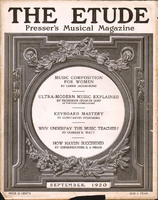By Stephen Walbrook
There are very few musicians of prominence who have not in their time been excitedly buttonholed by some inventive student who has established a new and especially simple form of musical notation which, according to the propaganda of the originator, will reform the whole art of music!
It is not inconceivable that our notation could be improved upon in many ways. Indeed the writer has seen two or three different versions of new notations, some departing very widely from the staff and clef idea, all of which might with practice be more easily read than the present notation.
Sir Charles Villers Stanford in his history of music (Stanford-Forsyth) says that the invention of new notations in the middle ages became “a sort of fashionable amusement in monkish circles.” Our own notation is merely a case of the survival of the fittest and has undergone many gradual changes from the time of its earliest inception with the one, two, three and four line staves.
The only real competition that the established notation has had has been the Tonic Sol Fa, admittedly excellent for certain kinds of sight-reading and choral purposes, but limited in its possibilities. This has been largely confined to the choral workers of Great Britain and her possessions. The so-called “shaped” or “buckwheat” notes used in rural portions of the United States for over half a century have their adherents, and we have been told time and again of local wars fought in their behalf with an animosity which is only equalled by that involving politics and religion.
The reason why new notations cannot be introduced is simply that there is a capital interest in the old notation represented by millions and millions of dollars spent by the publishers in existing publications and in musical plates. One can hardly expect the publishers to “junk” this valuable property for the sake of a few changes. The writer has been very much interested in the pedal sign introduced by The Etude years ago and employed to this day. This is unquestionably a very much more definite and much more legible mode of pedaling. Most of the great musicians who have used it have praised it with sincere enthusiasm. Yet—what is the result? Not one other publisher has adopted it thus far. In all probability, however, it will be one of the things which will gradually add itself to the notation just as, for instance, “signatures” were added.



